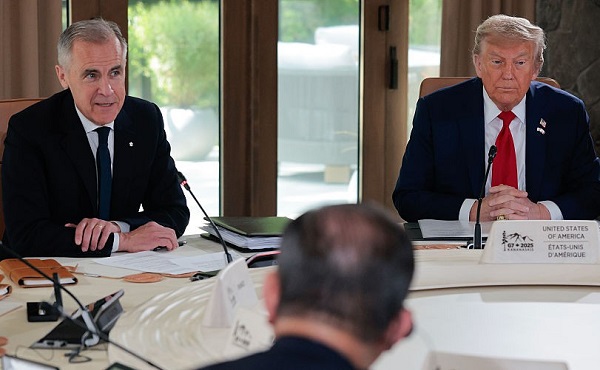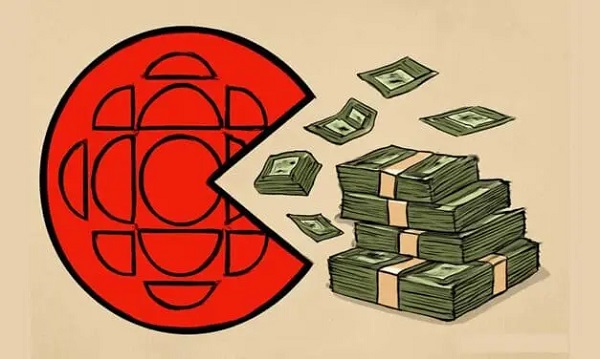Business
Bitter legacy hangs over today’s energy discussions between Quebec and N.L. premiers
Newfoundland and Labrador Premier Andrew Furey and Quebec Premier François Legault pose in the office of the premier at the Confederation Building, in St. John’s, on Friday, Feb. 24, 2023. THE CANADIAN PRESS/Paul Daly
By Sarah Smellie in St. John’s
As Quebec Premier François Legault seeks a new energy deal with Newfoundland and Labrador, he faces a public in the Atlantic province scarred by the legacy of a pair of hydroelectric projects mired in missteps.
Legault travelled to St. John’s this week for discussions with Newfoundland and Labrador Premier Andrew Furey about the 1969 Churchill Falls hydroelectric energy deal — and what will come after it ends in 2041. The lopsided deal heavily favours Quebec, and has left a lasting bitterness in Newfoundland and Labrador.
The two leaders are scheduled to speak with reporters later on Friday after the meeting.
Jeff Webb, a historian at Memorial University, says some residents of Newfoundland and Labrador think the province wouldn’t have endured the “humiliation” of needing equalization payments from the federal government if the Churchill Falls agreement had more evenly served both provinces.
“It does speak to people’s sense that this is something that’s always been rightly ours, and it’s been stolen,” Webb said in a recent interview.
Decades later, that hostility drove people in Newfoundland and Labrador to embrace the Muskrat Falls hydroelectric project, which is long delayed and draining the provincial purse, Webb said.
The 1969 Churchill Falls deal allows Quebec’s provincially owned hydroelectric utility, Hydro-Québec, to purchase 85 per cent of the electricity generated by the dam in Labrador, and therefore reap most of the profits. As of 2019, the deal had yielded close to $28 billion in profits to Quebec, and about $2 billion for Newfoundland and Labrador.
Under the agreement, Hydro-Québec pays a fixed price of 0.2 cents per kilowatt hour for Churchill Falls power. By comparison, the utility said in a news release this week it made an average of 8.2 cents per kilowatt hour on power it sold outside the province in 2022. Hydro-Québec made a record-breaking income of $4.6 billion last year, the release said.
The Innu of Uashat mak Mani-utenam in Quebec filed a $2.2-billion lawsuit against Hydro-Québec earlier this year, claiming the Churchill Falls hydroelectric station has destroyed a significant part of their traditional territory. In 2020, the Innu Nation in Labrador launched a $4-billion lawsuit against Hydro-Québec and Churchill Falls (Labrador) Corp., a subsidiary of Newfoundland and Labrador Hydro, for the ecological and cultural damage caused by the damming of the upper Churchill River in the early 1970s.
Pam Frampton, who retired in 2021 as the managing editor of The Telegram newspaper in St. John’s, said she grew up under the shadow of Churchill Falls.
“There was always these associated feelings of shame and bitterness, and the feeling that we had been duped,” Frampton said in an interview.
Frampton said she believes the province would be in a completely different economic position now if the Churchill Falls arrangement had not been so skewed.
“Wanting to give Quebec the middle finger, if you will, was a part of the impetus behind Muskrat Falls,” Frampton said. “I think if we had a fair day’s deal with (Churchill Falls), we wouldn’t have been so hell-bent on getting (Muskrat Falls) developed at any cost.”
Like the Churchill Falls project, the Muskrat Falls development harnesses the power of the Churchill River, in Labrador, and it also sits on traditional Innu territory. It was green-lit in December of 2012 after much trumpeting and fanfare by the Progressive Conservative government at the time, particularly by premier Danny Williams, who quit politics in late 2010.
Muskrat Falls has been disastrous for the province’s finances and morale. Its price tag now sits at more than $13 billion, a figure Andrew Furey described in 2021 as “an anchor around the collective souls of Newfoundland and Labradorians.”
Legault has said he wants a “win-win” deal for Quebec and Newfoundland and Labrador — and has even suggested paying the province more for electricity before the current deal ends in 2041.
Frampton said the Quebec premier needs to know that the people of Newfoundland and Labrador are hardened and still smarting from both projects.
“I think he needs to know that, going in, we are gun shy, and for good reason,” she said. “He should expect us to ask the hard questions. And I certainly hope to God our government does, on our behalf.”
This report by The Canadian Press was first published Feb. 24, 2023.
Business
Rhetoric—not evidence—continues to dominate climate debate and policy

From the Fraser Institute
Myths, fallacies and ideological rhetoric continue to dominate the climate policy discussion, leading to costly and ineffective government policies,
according to a new study published today by the Fraser Institute, an independent, nonpartisan Canadian public policy think-tank.
“When considering climate policies, it’s important to understand what the science and analysis actually show instead of what the climate alarmists believe to be true,” said Kenneth P. Green, Fraser Institute senior fellow and author of Four Climate Fallacies.
The study dispels several myths about climate change and popular—but ineffective—emission reduction policies, specifically:
• Capitalism causes climate change: In fact, according to several environment/climate indices and the Fraser Institute’s annual Economic Freedom of the World Index, the more economically free a country is, the more effective it is at protecting its environment and combatting climate change.
• Even small-emitting countries can do their part to fight climate change: Even if Canada reduced its greenhouse gas emissions to zero, there would be
little to no measurable impact in global emissions, and it distracts people from the main drivers of emissions, which are China, India and the developing
world.
• Vehicle electrification will reduce climate risk and clean the air: Research has shown that while EVs can reduce GHG emissions when powered with
low-GHG energy, they often are not, and further, have offsetting environmental harms, reducing net environmental/climate benefits.
• Carbon capture and storage is a viable strategy to combat climate change: While effective at a small scale, the benefits of carbon capture and
storage to reduce global greenhouse gas emissions on a massive scale are limited and questionable.
“Citizens and their governments around the world need to be guided by scientific evidence when it comes to what climate policies make the most sense,” Green said.
“Unfortunately, the climate policy debate is too often dominated by myths, fallacies and false claims by activists and alarmists, with costly and ineffective results.”

Kenneth P. Green
Senior Fellow, Fraser Institute
Business
Canada’s economic pain could be a blessing in disguise

This article supplied by Troy Media.
 By Roslyn Kunin
By Roslyn Kunin
Tariffs, inflation, and falling incomes sound bad, but what if they’re forcing us to finally fix what’s broken?
Canada is facing serious economic headwinds—from falling incomes to rising inflation and U.S. trade hostility—but within this turmoil lies an opportunity. If we respond wisely, this crisis could become a turning point, forcing long-overdue reforms and helping us build a stronger, more independent economy.
Rather than reacting out of frustration, we can use these challenges to reassess what’s holding us back and move forward with practical solutions. From
trade policy to labour shortages and energy development, there are encouraging shifts already underway if we stay focused.
A key principle when under pressure is not to make things worse for ourselves. U.S. tariffs on Canadian steel and aluminum, and the chaotic renegotiation of NAFTA/CUSMA, certainly hurt our trade-dependent economy. But retaliatory tariffs don’t work in our favour. Canadian imports make
up a tiny fraction of the U.S. economy, so countermeasures barely register there, while Canadian consumers end up paying more. The federal government’s own countertariffs on items like orange juice and whisky raised costs here without changing American policy.
Fortunately, more Canadians are starting to realize this. Some provinces have reversed bans on U.S. goods. Saskatchewan, for example, recently lifted
restrictions on American alcohol. These decisions reflect a growing recognition that retaliating out of pride often means punishing ourselves.
More constructively, Canada is finally doing what should have happened long ago: diversifying trade. We’ve put too many economic eggs in one
basket, relying on an unpredictable U.S. market. Now, governments and businesses are looking for buyers elsewhere, an essential step toward greater stability.
At the same time, we’re starting to confront domestic barriers that have held us back. For years, it’s been easier for Canadian businesses to trade with the U.S. than to ship goods across provincial borders. These outdated restrictions—whether on wine, trucks or energy—have fractured our internal market. Now, federal and provincial governments are finally taking steps to create a unified national economy.
Labour shortages are another constraint limiting growth. Many Canadian businesses can’t find the skilled workers they need. But here, too, global shifts
are opening doors. The U.S.’s harsh immigration and research policies are pushing talent elsewhere, and Canada is emerging as the preferred alternative.
Scientists, engineers and graduate students, especially in tech and clean energy, are increasingly choosing Canada over the U.S. due to visa uncertainty and political instability. Our universities are already benefiting. If we continue to welcome international students and skilled professionals, we’ll gain a long-term advantage.
Just as global talent is rethinking where to invest their future, Canada has a chance to reassert leadership in one of its foundational industries: energy.
The federal government is now adopting a more balanced climate policy, shifting away from blanket opposition to carbon-based energy and focusing instead on practical innovation. Technologies such as carbon capture and storage are reducing emissions and helping clean up so-called dirty oil. These cleaner energy products are in demand globally.
To seize that opportunity, we need infrastructure: pipelines, refining capacity and delivery systems to get Canadian energy to world markets and across our own country. Projects like the Trans Mountain pipeline expansion, along with east-west grid connections and expanded refining, are critical to reducing dependence on U.S. imports and unlocking Canada’s full potential.
Perhaps the most crucial silver lining of all is a renewed awareness of the value of this country. As we approach July 1, more Canadians are recognizing how fortunate we are. Watching the fragility of democracy in the U.S., and confronting the uncomfortable idea of being reduced to a 51st state, has reminded us that Canada matters. Not just to us, but to the world.
Dr. Roslyn Kunin is a respected Canadian economist known for her extensive work in economic forecasting, public policy, and labour market analysis. She has held various prominent roles, including serving as the regional director for the federal government’s Department of Employment and Immigration in British Columbia and Yukon and as an adjunct professor at the University of British Columbia. Dr. Kunin is also recognized for her contributions to economic development, particularly in Western Canada.
Troy Media empowers Canadian community news outlets by providing independent, insightful analysis and commentary. Our mission is to support local media in helping Canadians stay informed and engaged by delivering reliable content that strengthens community connections and deepens understanding across the country.
-

 Energy2 days ago
Energy2 days agoKananaskis G7 meeting the right setting for U.S. and Canada to reassert energy ties
-

 Business2 days ago
Business2 days agoCarney’s Honeymoon Phase Enters a ‘Make-or-Break’ Week
-

 Aristotle Foundation2 days ago
Aristotle Foundation2 days agoThe Canadian Medical Association’s inexplicable stance on pediatric gender medicine
-

 Alberta2 days ago
Alberta2 days agoAlberta announces citizens will have to pay for their COVID shots
-

 conflict2 days ago
conflict2 days agoIsrael bombs Iranian state TV while live on air
-

 Business2 days ago
Business2 days agoCarney praises Trump’s world ‘leadership’ at G7 meeting in Canada
-

 Business1 day ago
Business1 day agoThe CBC is a government-funded giant no one watches
-

 conflict2 days ago
conflict2 days agoTrump leaves G7 early after urging evacuation of Tehran






